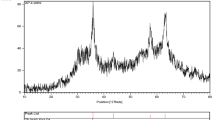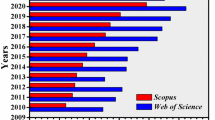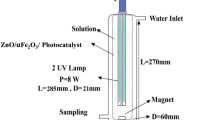Abstract
Metaldehyde is a selective molluscicide used in the agricultural and residential sector to control slugs and snails for a wide variety of crops. In recent years, some water companies have started monitoring drinking water supply catchments for presence of this compound, with positive and concern results. Conventional techniques are yet to achieve complete efficient and feasible removal of metaldehyde. The aim of this study was to measure the efficiency of nano-sized zinc oxide/laponite composites (NZnC) in the effective removal of metaldehyde (influent concentration of 500 μg dm−3) through the interaction of photocatalysis. Reaction time, pH of sample solution and NZnC mass were tested against each other using a rotatable central composite design method of experimentation. Statistical tests showed that linear effects of time, quadratic/linear effects of NZnC mass and the interaction of pH and NZnC mass proved to be the most significant variables for degrading metaldehyde. Optimal values of each variable for the highest removal efficiency were achieved, being pH equal to 10.4 and NZnC mass added equal to 28 g. The rate of reaction was then predicted by non-linear regression of four models. The best fit was provided by the modified first-order with residual kinetic model, with the apparent degradation coefficient k equal to 0.0363 min−1 and the lowest remaining metaldehyde concentration observed among all runs was 278.7 μg dm−3. NZnC has shown to be a prominent nanotechnology for metaldehyde removal.





Similar content being viewed by others
References
Ali, R., Abu Bakar, W. A. W., & Teck, L. K. (2010). Zn/ZnO/TiO2 and Al/Al2O3/TiO2 photocatalysts for the degradation of cypermethrin. Modern Applied Science, 4, 59–67.
Azami, M., Bahram, M., Nouri, S., & Naseri, A. (2012). A central composite design for the optimization of the removal of the azo dye, methyl orange, from waste water using the Fenton reaction. Journal of the Serbian Chemical Society, 77, 235–246.
Badawy, M. I., Ghaly, M. Y., & Gad-Allah, T. A. (2006). Advanced oxidation processes for the removal of organophosphorus pesticides from wastewater. Desalination, 194, 166–175.
Daneshvar, N., Aber, S., Seyed Dorraji, M. S., Khataee, A. R., & Rasoulifard, M. H. (2007). Preparation and investigation of photocatalytic properties of ZnO nanocrystals: effect of operational parameters and kinetic study. World Academy of Science, Engineering and Technology, 29, 267–272.
Evgenidou, E., Kytianos, K., & Poulios, I. (2005). Semiconductor-sensitized photodegradation of dichlorvos in water using TiO2 and ZnO as catalysts. Applied Catalysis B: Environmental, 59, 81–89.
GDNP (2006) Overview and comparison of conventional water treatment technologies and nano-based treatment technologies. Background Paper for the International Workshop on Nanotechnology, Water and Development. http://www.merid.org/nano/watertechpaper. Accessed 25 Mar 2012.
Grčić, I., Mužic, M., Vujević, D., & Koprivanac, N. (2009). Evaluation of atrazine degradation in UV/FeZSM-5/H2O2 system using factorial experimental design. Chemical Engineering Journal, 150, 475–484.
Hillie, T., & Hlophe, M. (2007). Nanotechnology and the challenge of clean water. Nature Nanotechnology, 2, 663–664.
Hillocks, R. J. (2012). Farming with fewer pesticides: EU pesticide review and resulting challenges for UK agriculture. Crop Protection, 31, 85–93.
Hoffman, A. J., Carraway, E. R., & Hoffmann, M. R. (1994). Photocatalytic production of H2O2 and organic peroxides on quantum-sized semiconductor colloids. Environmental Science and Technology, 28, 776–785.
Hoffmann, M. R., Martin, S. T., Choi, W., & Bahnemannt, D. W. (1995). Environmental applications of semiconductor photocatalysis. Chemical Reviews, 95, 69–96.
INCHEM (2011). Chemical Safety Information from Intergovernmental Organizations. http://www.inchem.org/. Accessed 25 Mar 2012.
Kim JK. (2012). Removal of pharmaceutical and personal care products using UV/TCNSP composite process in water. PhD Thesis 2012. University College London
Markowicz, A. (2011). An overview of quantification methods in energy-dispersive X-ray fluorescence analysis. Indian Academy of Sciences, 76, 321–329.
Mousavi, S. A. R., Mahvi, A. H., Nasseri, S., & Ghafari, S. (2011). Effect of Fenton process (H2O2/Fe2+) on removal of linear alkylbenzene sulfonate using central composite. Iranian Journal of Environmental Health Science and Engineering, 8, 129–138.
Pesticide Action Network–PAN (2011). Pesticide Database http://www.pesticideinfo.org/. Accessed 25 Mar 2012.
Pirkanniemi, K., & Sillanpää, M. (2002). Heterogeneous water phase catalysis as an environmental application: a review. Chemosphere, 48, 1047–1060.
Piscopo, A., Robert, D., & Weber, J. V. (2001). Influence of pH and chloride anion on the photocatalytic degradation of organic compounds Part I. Effect on the benzamide and para-hydroxybenzoic acid in TiO2 aqueous solution. Applied Catalysis B: Environmental, 35, 117–124.
Rousseau, R. M. (2001). Detection limit and estimate of uncertainty of analytical XRF results. The Rigaku Journal, 18, 33–47.
Santos, M. S. F., Alves, A., & Madeira, L. M. (2011). Paraquat removal from water by oxidation with Fenton’s reagent. Chemical Engineering Journal, 175, 279–290.
Savage, N., & Diallo, M. S. (2005). Nanomaterials and water purification: opportunities and challenges. Journal of Nanoparticle Research, 7, 331–342.
Shibayama, M., Sato, M., Kimura, Y., Fujiwara, H., & Nomura, S. (1988). 11B n.m.r. study on the reaction of poly(vinyl alcohol) with boric acid. Polymer, 29, 336–340.
Sudarjanto, G., Lehman-Keller, B., & Keller, J. (2006). Optimization of integrated chemical-biological degradation of a reactive azo dye using response surface methodology. Journal of Hazardous Material, B138, 160–168.
Topalov, A., Molnár-Gábor, D., & Csanádi, J. (1999). Photocatalytic oxidation of the fungicide metalaxyl dissolved in water over TiO2. Water Research, 33, 1371–1376.
UK Environmental Agency (2009). The determination of metaldehyde in waters using chromatography with mass spectrometric detection. London: EA. http://www.environment agency.gov.uk/static/documents/Research/Metaldehyde-226b.pdf. Accessed 25 Mar 2012.
UK Environmental Agency (2011). Environment Agency position on Metaldehyde, v.2. London: EA. http://publications.environment-agency.gov.uk/PDF/GEHO0811BTVG-E-E.pdf. Accessed 25 Mar 2012.
Wong, C. C., & Chu, W. (2002). The direct photolysis and photocatalytic degradation of alachlor at different TiO2 and UV sources. Chemosphere, 50, 981–987.
Acknowledgments
This project was supported by the Korean Ministry of Environment as “The GAIA project (no. 2012000550005)”. Dr A. C. Borges was supported by the Brazilian Research Council (CNPq-PDE 202096/2010-6).
Author information
Authors and Affiliations
Corresponding author
Rights and permissions
About this article
Cite this article
Doria, F.C., Borges, A.C., Kim, J.K. et al. Removal of Metaldehyde Through Photocatalytic Reactions Using Nano-Sized Zinc Oxide Composites. Water Air Soil Pollut 224, 1434 (2013). https://doi.org/10.1007/s11270-013-1434-3
Received:
Accepted:
Published:
DOI: https://doi.org/10.1007/s11270-013-1434-3




